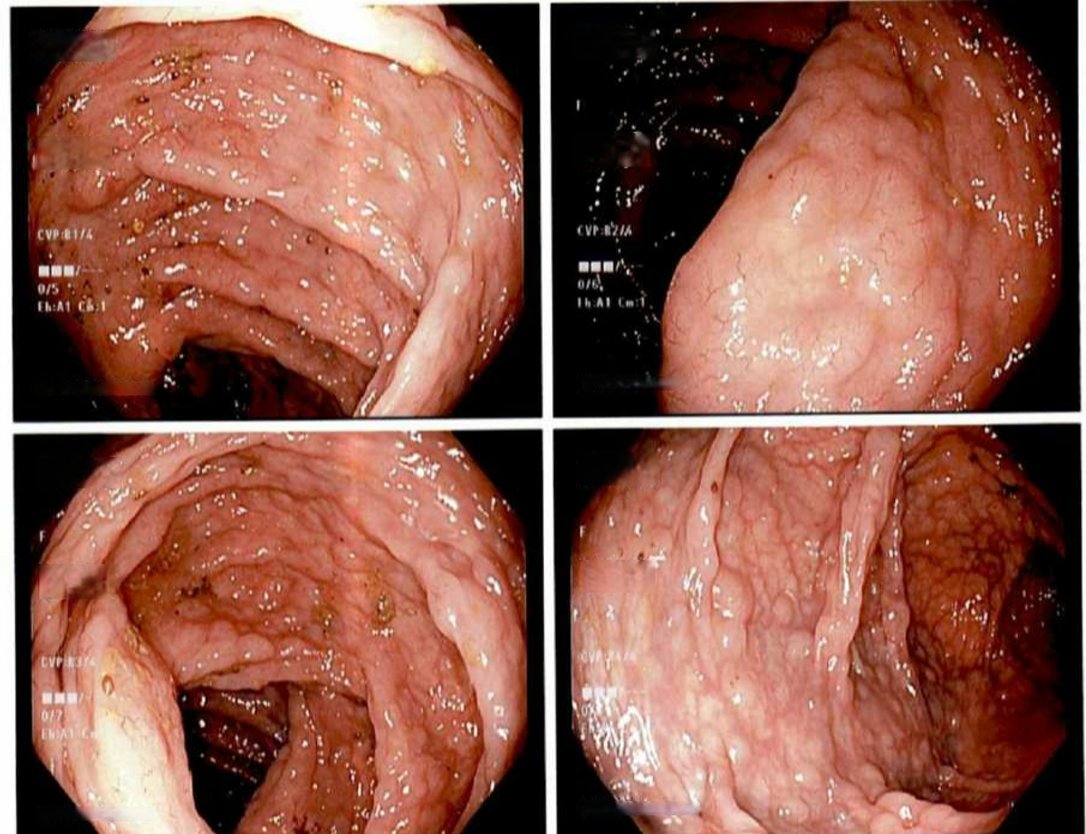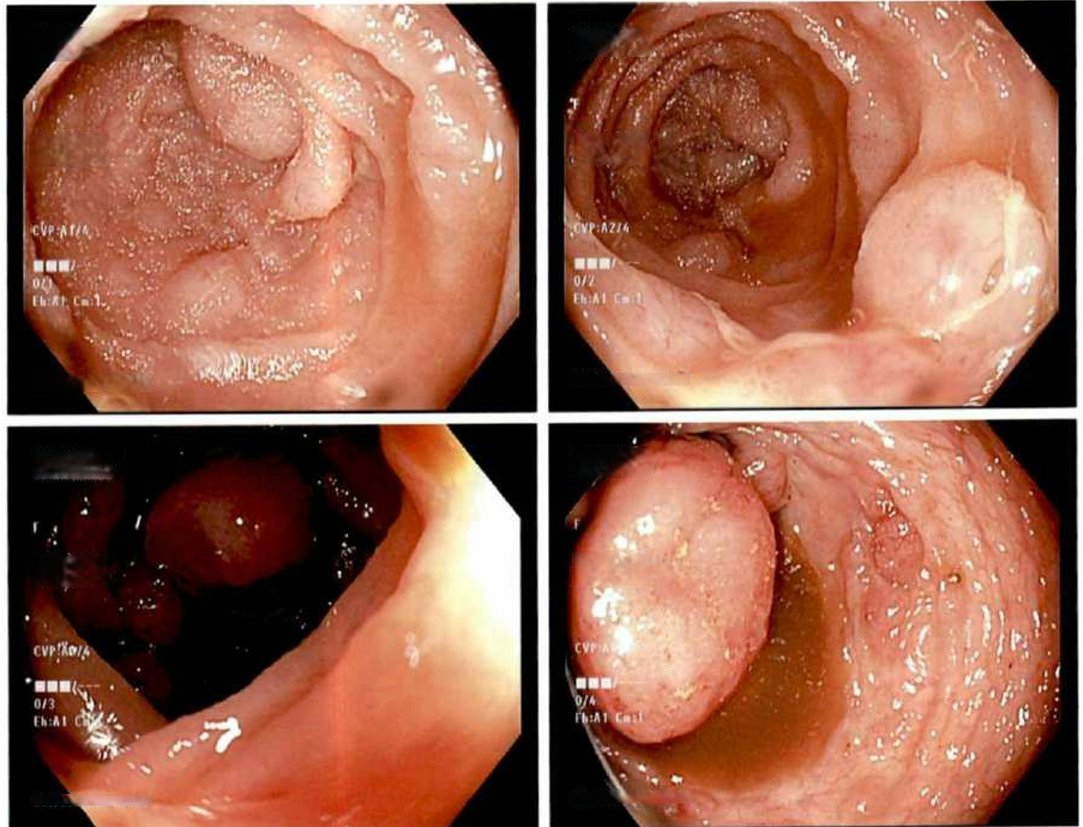Sunday Poster Session
Category: Colon
P0334 - From Multiple Polyps to Mantle Cell Lymphoma: A Rare Case of Multiple Lymphomatous Polyposis
Sunday, October 26, 2025
3:30 PM - 7:00 PM PDT
Location: Exhibit Hall

Fnu Rashi, MD
Henry Ford Macomb Hospital
Clinton Township, TX
Presenting Author(s)
Fnu Rashi, MD, Rene Peleman, MD
Henry Ford Macomb Hospital, Clinton Township, MI
Introduction:
Introduction: Mantle Cell Lymphoma (MCL) is a type of B cell Non-Hodgkin Lymphoma (NHL) with incidence of 5-6% amongst all cases of NHL. It is more common in males with a median age of presentation between 60-70 years. Multiple lymphomatous polyposis is a rare type of MCL involving the gastrointestinal (GI) tract. We present a case of a female patient with abdominal symptoms having this rare malignancy.
Case Description/
Methods: A 74-year-old woman with past medical history remarkable for hypothyroidism, low back pain, gastroesophageal reflux disease, presented to us with chief complaint of lower abdominal pain. She reported that the pain started approximately 2 weeks ago in the lower back that transitioned to the lower abdomen, particularly the left lower quadrant. Computed tomography of abdomen pelvis revealed acute diverticulitis in the proximal ascending colon with peri colonic abscess measuring about 3.3 cm. She was treated with antibiotics and underwent a follow-up colonoscopy in 6 weeks. The colonoscopy was remarkable for numerous polyps from terminal ileum to the rectum that were hyperplastic versus hamartomatous on visualization. There was a single large polyp in the cecum that was biopsied and not removed due to size. The biopsy revealed polypoid fragments of cecal mucosa with MCL (multiple lymphomatous polyposis). Subsequently bone marrow biopsy was done which did not show any overt lymphoma. After multidisciplinary tumor board discussion, it was decided to start the patient on bendamustine and rituximab followed by rituximab maintenance therapy.
Discussion: All multiple submucosal polyps are sent for histological and cytological analysis as several GI tumors can present with similar morphological features however, distinguishing them can significantly affect treatment decisions and hence, patient outcomes. Most of the cases of MPL have associated GI symptoms, however there are cases in literature where patients have presented with non-GI symptoms such as cough and shortness of breath. It is important to include MPL as a differential when dealing multiple polyposis of GI tract. This case highlights the importance of early diagnosis through comprehensive evaluation including both endoscopy and histopathology. Despite current available treatments prognosis of MPL is very poor and more targeted therapy will hopefully be available in future.

Figure: Endoscopic image showing multiple polyps throughout the colon

Figure: Endoscopic image showing multiple polyps throughout the colon
Disclosures:
Fnu Rashi indicated no relevant financial relationships.
Rene Peleman indicated no relevant financial relationships.
Fnu Rashi, MD, Rene Peleman, MD. P0334 - From Multiple Polyps to Mantle Cell Lymphoma: A Rare Case of Multiple Lymphomatous Polyposis, ACG 2025 Annual Scientific Meeting Abstracts. Phoenix, AZ: American College of Gastroenterology.
Henry Ford Macomb Hospital, Clinton Township, MI
Introduction:
Introduction: Mantle Cell Lymphoma (MCL) is a type of B cell Non-Hodgkin Lymphoma (NHL) with incidence of 5-6% amongst all cases of NHL. It is more common in males with a median age of presentation between 60-70 years. Multiple lymphomatous polyposis is a rare type of MCL involving the gastrointestinal (GI) tract. We present a case of a female patient with abdominal symptoms having this rare malignancy.
Case Description/
Methods: A 74-year-old woman with past medical history remarkable for hypothyroidism, low back pain, gastroesophageal reflux disease, presented to us with chief complaint of lower abdominal pain. She reported that the pain started approximately 2 weeks ago in the lower back that transitioned to the lower abdomen, particularly the left lower quadrant. Computed tomography of abdomen pelvis revealed acute diverticulitis in the proximal ascending colon with peri colonic abscess measuring about 3.3 cm. She was treated with antibiotics and underwent a follow-up colonoscopy in 6 weeks. The colonoscopy was remarkable for numerous polyps from terminal ileum to the rectum that were hyperplastic versus hamartomatous on visualization. There was a single large polyp in the cecum that was biopsied and not removed due to size. The biopsy revealed polypoid fragments of cecal mucosa with MCL (multiple lymphomatous polyposis). Subsequently bone marrow biopsy was done which did not show any overt lymphoma. After multidisciplinary tumor board discussion, it was decided to start the patient on bendamustine and rituximab followed by rituximab maintenance therapy.
Discussion: All multiple submucosal polyps are sent for histological and cytological analysis as several GI tumors can present with similar morphological features however, distinguishing them can significantly affect treatment decisions and hence, patient outcomes. Most of the cases of MPL have associated GI symptoms, however there are cases in literature where patients have presented with non-GI symptoms such as cough and shortness of breath. It is important to include MPL as a differential when dealing multiple polyposis of GI tract. This case highlights the importance of early diagnosis through comprehensive evaluation including both endoscopy and histopathology. Despite current available treatments prognosis of MPL is very poor and more targeted therapy will hopefully be available in future.

Figure: Endoscopic image showing multiple polyps throughout the colon

Figure: Endoscopic image showing multiple polyps throughout the colon
Disclosures:
Fnu Rashi indicated no relevant financial relationships.
Rene Peleman indicated no relevant financial relationships.
Fnu Rashi, MD, Rene Peleman, MD. P0334 - From Multiple Polyps to Mantle Cell Lymphoma: A Rare Case of Multiple Lymphomatous Polyposis, ACG 2025 Annual Scientific Meeting Abstracts. Phoenix, AZ: American College of Gastroenterology.
